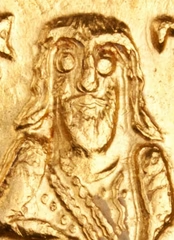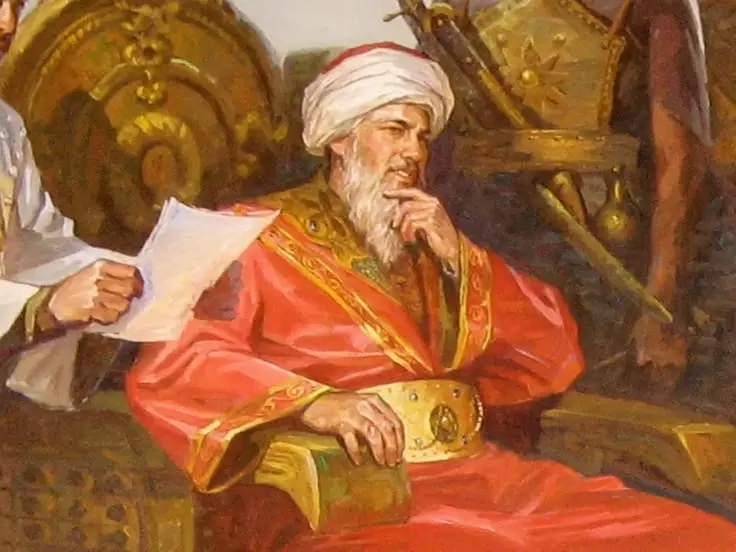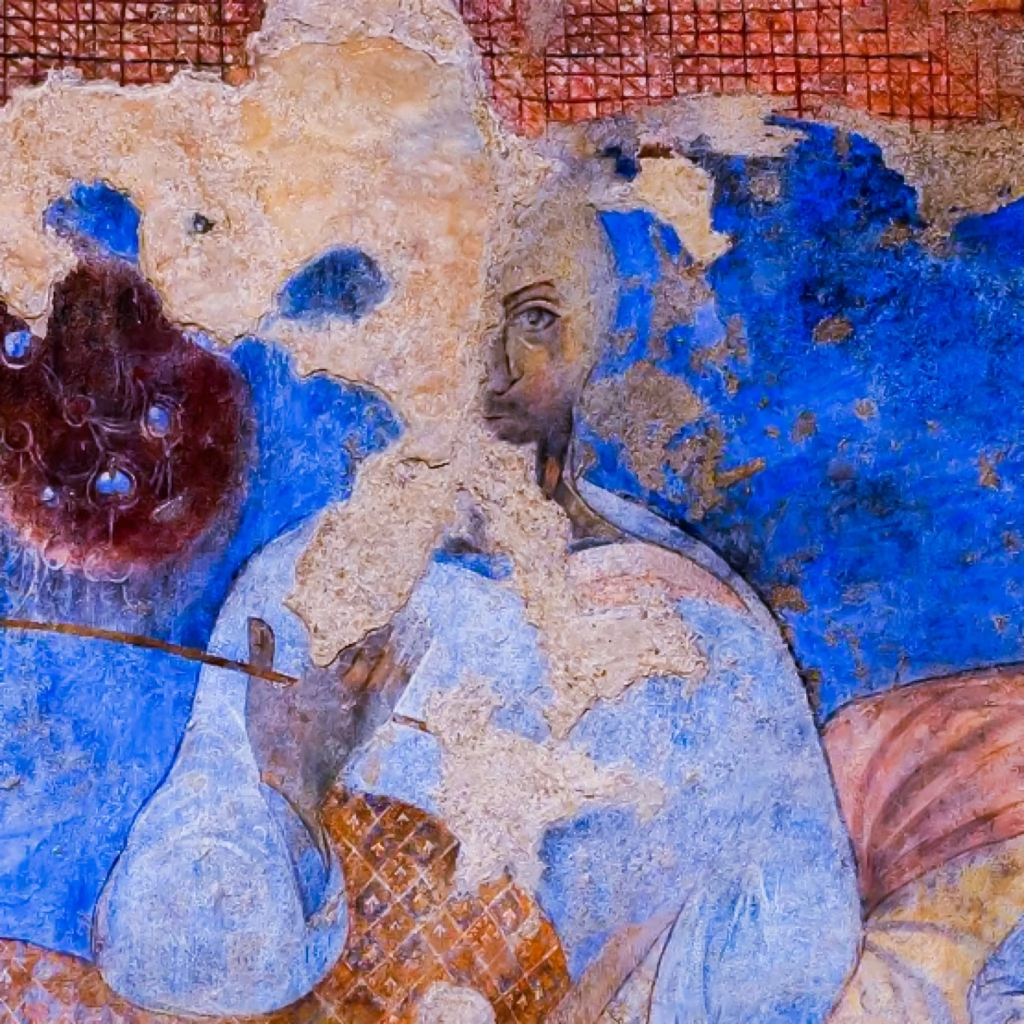This chart illustrate Family Tree of Umayyad Dynasty (Banu Umayya) in English & Urdu. Banu Umayya, commonly referred to as the Umayyads, form one of the most significant dynasties in Islamic history.

See Also: Prophet Muhammad (PBUH) Family Tree: Quraysh to Imam Mahdi
Key Figures and Early Leadership
- Abd Manaf and Abd Shams
Abd Manaf, a common ancestor, had several sons. One of his sons, Abd Shams, fathered Umayya, after whom the Umayyad dynasty is named. Abd Shams’ descendants include key figures in the Umayyad Caliphate, particularly the Sufyani and Marwani branches. - Umayya and his Descendants
The Umayyad family began to rise in prominence through Umayya’s descendants, including Harb, Abu al-As, and Abu Sufyan. Abu Sufyan, an influential figure in the early Islamic period, initially opposed Prophet Muhammad (PBUH) but later embraced Islam after the conquest of Mecca. His son, Mu’awiya I, would later become the first Umayyad Caliph, marking the beginning of the dynasty’s rule.
Umayyad Caliphate/Empire
The Umayyad Caliphate or Empire began after the tumultuous end of the Rightly Guided Caliphs. Mu’awiya I, son of Abu Sufyan, established the Umayyad dynasty in 661 CE. He shifted the capital from Medina to Damascus, bringing significant administrative changes and expansion to the empire.
Branches of the Umayyads
The family tree shows two main branches of the Umayyad family:
- The Sufyani Branch: Descendants of Abu Sufyan, including the early Umayyad Caliphs like Mu’awiya I and Yazid I.
- The Marwani Branch: Descendants of Marwan I, who took over after the decline of the Sufyani line. The Marwanids ruled from Marwan I, Abd al-Malik onward and played a significant role in strengthening the empire.
1. Mu’awiya I
Mu’awiya I or Mu’awiya ibn Abi Sufyan was the first Umayyad Caliph, ruling after the Rashidun Caliphs. Initially, he and his father opposed Prophet Muhammad, but after the Conquest of Mecca, Mu’awiya converted to Islam and became one of the Prophet’s scribes.
He rose through the ranks as a commander and later became governor of Syria under Caliph Uthman. After Uthman’s assassination Mu’awiya opposed Caliph Ali, leading to the Battle of Siffin. After Ali’s assassination (661), Mu’awiya secured his rule and established the Umayyad Caliphate.
Domestically, he strengthened Syria, built administrative institutions, and relied on loyalist Arab tribes. Militarily, he expanded Islamic rule into North Africa, Khurasan, and Sijistan and launched raids against the Byzantine Empire. A controversial move was appointing his son, Yazid I, as his successor, which led to opposition from key Muslim figures, eventually sparking the Second Fitna (Second Muslim Civil War).
2. Yazid I
Yazid ibn Mu’awiya ibn Abi Sufyan, commonly known as Yazid I, was the second caliph of the Umayyad Caliphate, ruling from 680 until his death in 683. His appointment by his father Mu’awiya I was the first hereditary succession to the caliphate in Islamic history.
In 676 CE, Mu’awiya I appointed his son Yazid I as his successor, but many leaders in Hejaz, including Husayn ibn Ali, a grandson of Prophet Muhammad (PBUH) and Abd Allah ibn al-Zubayr, opposed this decision. After Yazid became caliph in 680 CE, both men refused to accept his rule and took refuge in Mecca. Husayn traveled to Kufa to lead a rebellion but was killed at the Battle of Karbala along with his supporters. His death angered many in Hejaz, where Abd Allah ibn al-Zubayr called for a new caliph to be chosen. The people of Medina also rebelled against Yazid.
After failed negotiations, Yazid sent an army, which defeated the Medinese at the Battle of al-Harra and sacked the city. The army then besieged Mecca, but withdrew after Yazid died in November 683, throwing the caliphate into decade-long civil war, ending with the establishment of the Marwanid line(the Umayyad Caliph Marwan I and his descendants).
3. Mu’awiya II
Mu’awiya ibn Yazid ibn Mu’awiya commonly known as Mu’awiya II, was the third Umayyad caliph, ruling for less than a year in 683–684. He succeeded his father Yazid I as the third caliph and last caliph of the Sufyanid Branch in the Umayyad dynasty.
His adviser Al-Dahhak ibn Qays al-Fihri took care of practical affairs. After 40 days however, Mu’awiya abdicated from the throne. He said to his family members:
‘My father was cruel. He massacred the family of the Prophet for the throne. Therefore I curse this throne… give it to whoever you want.’
See Also: Banu Umayya and Banu Hashim Family Tree
4. Marwan I
Marwan I was the fourth Umayyad caliph, ruling briefly from 684 to 685 CE. He founded the Marwanid Branch of Umayyad, which led the Umayyad Caliphate until 750 CE.
During his cousin Caliph Uthman’s reign (644–656 CE), Marwan fought against the Byzantines in North Africa, served as governor of Fars, and later became Uthman’s secretary. He was wounded defending Uthman when the caliph was assassinated. Afterward, he fought alongside Lady A’isha’s supporters against Caliph Ali at the Battle of the Camel (656 CE).
Under Mu’awiya I, Marwan governed Medina. Later, during Yazid I’s reign, he defended the Umayyads in Hejaz against opposition, including Husayn ibn Ali’s revolt. After Yazid’s death in 683 CE, Abd Allah ibn al-Zubayr declared himself caliph and expelled Marwan, who fled to Syria. With the death of Mu’awiya II in 684 CE, pro-Umayyad Syrian tribes chose Marwan as caliph at a tribal gathering in Jabiya. He then defeated the pro-Zubayrid Qays tribes at the Battle of Marj Rahit (684 CE), securing his rule.
5. Abd al-Malik ibn Marwan
Abd al-Malik ibn Marwan was the fifth Umayyad caliph ruled from 685 to 705 who restored and strengthened the Umayyad Caliphate after the Second Fitna.
At first, he focused on securing Syria, made a temporary truce with the Byzantines, and defeated internal rebellions. In 692, his general al-Hajjaj ibn Yusuf crushed his main rival, Abd Allah ibn al-Zubayr, in Mecca, reunifying the Caliphate. Abd al-Malik expanded Umayyad rule into Anatolia, Armenia, and North Africa and strengthened control over Iraq and Khurasan. His rule brought stability and prosperity, and his centralized government became the model for later Muslim states.

6. Al-Walid I
Al-Walid ibn Abd al-Malik ibn Marwan commonly known as Al-Walid I was the sixth Umayyad caliph ruled from 705 to 715. He expanded his father’s policies, strengthening centralized rule and spreading Islamic influence. During his reign, Umayyad forces, led by al-Hajjaj ibn Yusuf, conquered Sind and Transoxiana in the east, while Musa ibn Nusayr led conquests in North Africa and Spain, making the Caliphate the largest in history.

Wealth from these victories funded major architectural projects, including the Great Mosque of Damascus, Al-Aqsa Mosque, and the expansion of the Prophet’s Mosque in Medina. He was also the first caliph to introduce social welfare programs. His rule brought peace and prosperity, marking the peak of Umayyad power, but his high military spending became a challenge for his successors.
7. Sulayman ibn Abd al-Malik
Sulayman ibn Abd al-Malik was the seventh Umayyad caliph ruled from 715 to 717. Before becoming caliph, he served as governor of Palestine under his father, Abd al-Malik, and brother, al-Walid I.
As caliph, he removed many of his predecessor’s top generals and governors, including Qutayba ibn Muslim (Central Asia), Muhammad ibn al-Qasim (Sind), and Musa ibn Nusayr (Iberian Peninsula). These dismissals weakened the Caliphate’s military leadership, causing territorial expansion to slow down.
See Also: Muhammad bin Qasim Family Tree
Sulayman focused on war with the Byzantine Empire, leading to the disastrous Arab siege of Constantinople (717–718). He died during the campaign in Dabiq, and instead of choosing his own son, he appointed his cousin Umar II as his successor.
His rule coincided with the 100th anniversary of the Hijra, and some poets saw him as a messianic figure.
8. Umar ibn Abd al-Aziz
Umar ibn Abd al-Aziz was the eighth Umayyad caliph ruling from 717 until his death in 720 and is known for his reforms and emphasis on justice and equality. He improved government efficiency, initiated the first official collection of hadiths, and mandated universal education. He promoted Islam by sending emissaries to China and Tibet and saw large-scale conversions in Persia and Egypt.
Unlike his predecessors, Umar reduced military campaigns, withdrawing forces from Constantinople, Central Asia, and Septimania, though Umayyad expansion in Iberia continued. Umar was considered by many to be the first mujaddid and the sixth righteous caliph of Islam after Ali and Hasan ibn Ali’s caliphate is considered with the caliphate of his father Ali because of a Hadith. He was honorifically called Umar al-Thani (Umar II) after his maternal great-grandfather, Caliph Umar ibn Al-Khattab.
9. Yazid II
Yazid ibn Abd al-Malik commonly known as Yazid II, was the ninth Umayyad caliph, ruling from 720 to 724. Though he had little administrative or military experience, he was respected for his lineage, being a descendant of Umayyad dynasty. He reversed the reforms of Umar II, reimposing the jizya (poll tax) on non-Arab Muslim converts and reviving military campaigns, particularly against the Khazars in the Caucasus and the Byzantines in Anatolia.
However, these efforts failed to resolve the empire’s financial crisis, as war booty declined and taxation met resistance. Yazid used Syrian troops to suppress revolts in Iraq, particularly the rebellion of Yazid ibn al-Muhallab, ending major anti-Umayyad uprisings there. The brutal suppression of the Muhallabid family fueled resentment, contributing to later support for the Abbasid Revolution, which overthrew the Umayyads in 750.
10. Hisham ibn Abd al-Malik
Hisham ibn Abd al-Malik was the tenth Umayyad caliph, ruling from 724 to 743. He was chosen as successor by his brother Yazid II, over Yazid’s son al-Walid II. Hisham inherited an empire facing many challenges, but he managed them effectively, keeping the Umayyad rule stable. His reign saw a revival of reforms started by Umar II, including a strict enforcement of Sharia, even on his own family.
He was a great patron of the arts and education, encouraging the translation of literary and scientific works into Arabic and expanding schools. He also commissioned the hadith scholar Ibn Shihab al-Zuhri to write down hadiths, contributing to their preservation. Hisham’s leadership allowed the Umayyad Caliphate to continue, but growing internal tensions would later weaken the dynasty.
11. Al-Walid II
Al-Walid ibn Yazid ibn Abd al-Malik commonly known as Al-Walid II, was the eleventh Umayyad caliph, ruling from 743 to 744. He succeeded his uncle, Hisham ibn Abd al-Malik. As caliph, he dismissed key officials and made controversial appointments, including replacing Nasr ibn Sayyar in Khurasan under the influence of Yusuf ibn Umar. His governance saw the rebellion of Yahya ibn Zayd, who was ultimately defeated and killed.

Al-Walid was known for his lavish lifestyle, including drinking, singing, and horse racing, which fueled opposition. His cousin, Yazid III, led a revolt against him with the backing of discontented factions. Al-Walid fought back but was defeated and killed on April 16, 744, near modern-day Jordan. This marked the beginning of the Umayyad Caliphate’s decline, as internal divisions weakened its authority.
12. Yazid III
Yazid ibn al-Walid commonly known as Yazid III, was the twelfth Umayyad caliph, ruling from 744 until his death months later. He was the son of Caliph al-Walid I and Shah-i Afrid, a Persian princess from the lineage of Peroz, a Sasanian ruler.
Upon taking power after overthrowing al-Walid II, Yazid positioned himself as a reformist. He claimed to rule according to the Quran and the Sunnah, advocating justice, fiscal responsibility, and fair governance. Despite his promises, Yazid III’s reign was short-lived. He fell ill with a brain tumor and died on October 3 or 4, 744, just months after taking power. Before his death, he appointed his brother Ibrahim as his successor.
13. Ibrahim ibn al-Walid
Ibrahim ibn al-Walid was an Umayyad caliph, and a son of Caliph al-Walid I. He ruled from 4 October 744 to 4 December 744. He was the penultimate Caliph of the Umayyad Caliphate. He went into hiding out of fear of his political opponents.
14. Marwan II
Marwan ibn Muhammad ibn Marwan commonly known as Marwan II, was the fourteenth and last caliph of the Umayyad Caliphate, ruling from 744 until his death. His reign was dominated by a civil war, and he was the last Umayyad ruler to rule the united Caliphate before the Abbasid Revolution toppled the Umayyad dynasty.
Umayyad Legacy
The Umayyads played a big role in spreading Islam across many lands. Their empire stretched from Spain and Portugal (Iberian Peninsula) to the Indus Valley in South Asia. Their rule covered three continents—Asia, Africa, and Europe. The Umayyads controlled their empire with a strong central government. They used local leaders to help manage different regions. They also made Arabic the official language for government and administration.
The dynasty was at its strongest during the rule of Abd al-Malik and his son Al-Walid I. They expanded the empire even more and made Damascus an important center of Islamic culture. However, over time, problems began to grow. Many non-Arab Muslims (Mawali) were unhappy with the Umayyad rule. Revolts and internal conflicts weakened the dynasty, leading to its decline.
See Also: Banu Abbas Family Tree (Abbasid Dynasty)




Really awesome the genealogy that you provide about various nations . Do you have any information about the khillji dynasty .Can U provide the genealogy of khillji dynasty from major branch to minor branch.